Home : BBW :

 With rare exception (some storage/closet cabinets), none of my cabinets have surface fasteners - no puttied nail/pin holes or cover caps. I use various specialized fasteners and designs that allow all components to be fastened from the back side. In the example image the custom fluted trim is mounted with keyhole brackets and the custom crown is mounted using a hidden tongue and grove on the top of the cabinet. Also note the even 3/4" reveal around the perimeter of the box and color matched recessed shelf supports.
With rare exception (some storage/closet cabinets), none of my cabinets have surface fasteners - no puttied nail/pin holes or cover caps. I use various specialized fasteners and designs that allow all components to be fastened from the back side. In the example image the custom fluted trim is mounted with keyhole brackets and the custom crown is mounted using a hidden tongue and grove on the top of the cabinet. Also note the even 3/4" reveal around the perimeter of the box and color matched recessed shelf supports.
[ comment | link | top ]
 Whether solid wood or veneer, selecting and making use of the patterns in the wood can have a huge impact on a cabinets overall appearance. The bigger the project the more complicated it can get. Veneered sheet goods are available sequentially matched which means the veneer is from the same tree and that the colors and patterns will be fairly consistent.
Whether solid wood or veneer, selecting and making use of the patterns in the wood can have a huge impact on a cabinets overall appearance. The bigger the project the more complicated it can get. Veneered sheet goods are available sequentially matched which means the veneer is from the same tree and that the colors and patterns will be fairly consistent.
The goal is to find a pattern that is balanced and can be repeated. With doors a flame looking pattern (AKA cathedral) is common. The image shows one possible layout for a pair of doors, the flame pattern is reasonably centered. The alternative layout, while it would have made better use of the material (less waste), is unbalanced and has a noticeable secondary pattern.
Getting a matching and balanced pair of doors is fairly easy. Getting side by side pairs to match can be tricky because the pattern needs to be similar in both height and width. In this case I needed three similar pairs and the layout was fairly easy.
Grain matching can be costly because it results in more wasted material. In this case centering the flame pattern left me with two long narrow pieces instead of one wider piece that could have been used for shelves. The waste from the height-wise matching was relatively insignificant.

 While some projects work out better than others, I will never do a pair of doors with both unmatched color and grain (right image, I've seen a lot worse). The left image is one of the book-matched matched pairs from the above layout (the knobs are temporary ones).
While some projects work out better than others, I will never do a pair of doors with both unmatched color and grain (right image, I've seen a lot worse). The left image is one of the book-matched matched pairs from the above layout (the knobs are temporary ones).
...The potential color difference between the doors and cabinet (e.g. the book-matched example above) had been a sore spot with me. Wood color can vary a lot from tree to tree and the only way to get a perfect color match is for all the wood to come from the same tree and the only way to do that is custom veneering. With custom veneering, even the backs of the doors match.
I now offer custom veneering. The additional cost of custom veneering varies from minimal to a lot. It depends on the project design, wood species/grain pattern desired and how soon you want it. I do stock a limited selection of veneers.
flexwood.com veneer cutting and matching
[ comment | link | top ]
Cabinets
I design and build everything from simple melamine storage cabinetry to complex hardwood built-ins. While I've probably done more painted built-ins than anything else, my preference is natural wood.
For some examples of my cabinetry, see Built-ins and Furniture (or the browse menu on the left). The project descriptions contain information on design, materials and construction. I'll use this page to provide more general and detailed information about my cabinets - design, specifications, features, options, etc.
If you have any questions, please Contact me.

For some examples of my cabinetry, see Built-ins and Furniture (or the browse menu on the left). The project descriptions contain information on design, materials and construction. I'll use this page to provide more general and detailed information about my cabinets - design, specifications, features, options, etc.
If you have any questions, please Contact me.
Styles
There are two basic cabinet styles, overlay and (inset) flush. The style refers to the position of the door and drawer faces relative to the face of the cabinet. Overlay means that the door and drawer faces sit on top of, and overlay (to some degree), the face of the cabinet. Flush, or inset flush, means that the drawer and door faces are moved back (inset) so that they are on the same plane as, i.e. flush to, the cabinet face. The door and drawer faces can be flush to the cabinet box itself or to trim that is applied to the cabinet box, e.g. a face frame.
I specialize in flush cabinetry, cabinetry with trim (typically 1-1/2") that frames the door and drawer faces. This style works well for any kind of cabinetry - furniture, built-in or wall hung - and has numerous design and construction options.
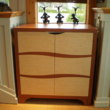
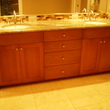
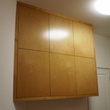
Other styles of cabinetry I do are full-inset, railed-inset and half-overlay. Full-inset is similar to my flush cabinetry (above), but the door and drawer faces are framed by the cabinet box (3/4"). With railed inset cabinetry, horizontal rails are added so that all door and drawer faces have a 3/4" frame around them (instead of just a perimeter frame). Half-overlay cabinets have relatively wide perimeter reveal (instead of a frame). While these styles are generally more economical, the design options are limited.
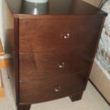
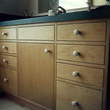

[ comment | link | top ]
I specialize in flush cabinetry, cabinetry with trim (typically 1-1/2") that frames the door and drawer faces. This style works well for any kind of cabinetry - furniture, built-in or wall hung - and has numerous design and construction options.



Other styles of cabinetry I do are full-inset, railed-inset and half-overlay. Full-inset is similar to my flush cabinetry (above), but the door and drawer faces are framed by the cabinet box (3/4"). With railed inset cabinetry, horizontal rails are added so that all door and drawer faces have a 3/4" frame around them (instead of just a perimeter frame). Half-overlay cabinets have relatively wide perimeter reveal (instead of a frame). While these styles are generally more economical, the design options are limited.



[ comment | link | top ]
Surface Fasteners

 With rare exception (some storage/closet cabinets), none of my cabinets have surface fasteners - no puttied nail/pin holes or cover caps. I use various specialized fasteners and designs that allow all components to be fastened from the back side. In the example image the custom fluted trim is mounted with keyhole brackets and the custom crown is mounted using a hidden tongue and grove on the top of the cabinet. Also note the even 3/4" reveal around the perimeter of the box and color matched recessed shelf supports.
With rare exception (some storage/closet cabinets), none of my cabinets have surface fasteners - no puttied nail/pin holes or cover caps. I use various specialized fasteners and designs that allow all components to be fastened from the back side. In the example image the custom fluted trim is mounted with keyhole brackets and the custom crown is mounted using a hidden tongue and grove on the top of the cabinet. Also note the even 3/4" reveal around the perimeter of the box and color matched recessed shelf supports.[ comment | link | top ]
Grain Matching
 Whether solid wood or veneer, selecting and making use of the patterns in the wood can have a huge impact on a cabinets overall appearance. The bigger the project the more complicated it can get. Veneered sheet goods are available sequentially matched which means the veneer is from the same tree and that the colors and patterns will be fairly consistent.
Whether solid wood or veneer, selecting and making use of the patterns in the wood can have a huge impact on a cabinets overall appearance. The bigger the project the more complicated it can get. Veneered sheet goods are available sequentially matched which means the veneer is from the same tree and that the colors and patterns will be fairly consistent. The goal is to find a pattern that is balanced and can be repeated. With doors a flame looking pattern (AKA cathedral) is common. The image shows one possible layout for a pair of doors, the flame pattern is reasonably centered. The alternative layout, while it would have made better use of the material (less waste), is unbalanced and has a noticeable secondary pattern.
Getting a matching and balanced pair of doors is fairly easy. Getting side by side pairs to match can be tricky because the pattern needs to be similar in both height and width. In this case I needed three similar pairs and the layout was fairly easy.
Grain matching can be costly because it results in more wasted material. In this case centering the flame pattern left me with two long narrow pieces instead of one wider piece that could have been used for shelves. The waste from the height-wise matching was relatively insignificant.

 While some projects work out better than others, I will never do a pair of doors with both unmatched color and grain (right image, I've seen a lot worse). The left image is one of the book-matched matched pairs from the above layout (the knobs are temporary ones).
While some projects work out better than others, I will never do a pair of doors with both unmatched color and grain (right image, I've seen a lot worse). The left image is one of the book-matched matched pairs from the above layout (the knobs are temporary ones)....The potential color difference between the doors and cabinet (e.g. the book-matched example above) had been a sore spot with me. Wood color can vary a lot from tree to tree and the only way to get a perfect color match is for all the wood to come from the same tree and the only way to do that is custom veneering. With custom veneering, even the backs of the doors match.
I now offer custom veneering. The additional cost of custom veneering varies from minimal to a lot. It depends on the project design, wood species/grain pattern desired and how soon you want it. I do stock a limited selection of veneers.
flexwood.com veneer cutting and matching
[ comment | link | top ]
